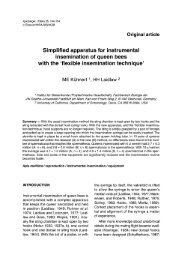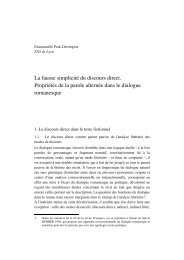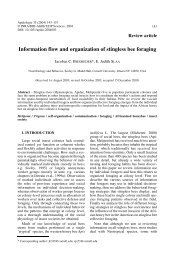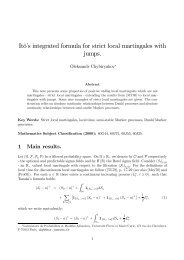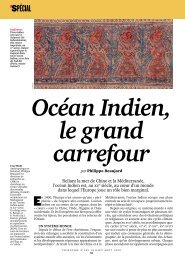Etude de capacités en couches minces à base d'oxydes métalliques ...
Etude de capacités en couches minces à base d'oxydes métalliques ...
Etude de capacités en couches minces à base d'oxydes métalliques ...
You also want an ePaper? Increase the reach of your titles
YUMPU automatically turns print PDFs into web optimized ePapers that Google loves.
tel-00141132, version 1 - 11 Apr 2007<br />
Chapitre 6 : Capacités MIM STO/BTO<br />
Chapitre 6 : Capacités MIM STO/BTO<br />
Ce chapitre est consacré <strong>à</strong> l’élaboration et la caractérisation <strong>de</strong> <strong>capacités</strong> MIM <strong>à</strong> <strong>base</strong> <strong>de</strong><br />
multi<strong>couches</strong> SrTiO3/BaTiO3 déposés par IBS.<br />
Dans un premier temps un état <strong>de</strong> l’art <strong>de</strong>s dépôts SrTiO3/BaTiO3 ainsi que l’intérêt <strong>de</strong> ces<br />
empilem<strong>en</strong>ts sont prés<strong>en</strong>tés. Nous abordons <strong>en</strong>suite la stratégie d’élaboration <strong>de</strong> nos<br />
multi<strong>couches</strong> ainsi que la caractérisation électrique et physico-chimique <strong>de</strong>s <strong>capacités</strong>.<br />
Une caractérisation par microscopie électronique <strong>en</strong> transmission (MET) a égalem<strong>en</strong>t été<br />
effectuée afin <strong>de</strong> mieux compr<strong>en</strong>dre les phénomènes d’interface.<br />
Sommaire__________________________________________________________________<br />
1. Etat <strong>de</strong> l’art................................................................................................................213<br />
1.1. Intérêt <strong>de</strong>s multi<strong>couches</strong> STO/BTO.....................................................................213<br />
1.2. Synthèse bibliographique ....................................................................................214<br />
2. Elaboration <strong>de</strong>s multi<strong>couches</strong>.....................................................................................218<br />
2.1. Essais préliminaires.............................................................................................218<br />
2.2. Réalisation <strong>de</strong>s empilem<strong>en</strong>ts ...............................................................................220<br />
2.2.1. Choix <strong>de</strong>s empilem<strong>en</strong>ts................................................................................220<br />
2.2.2. Elaboration <strong>de</strong>s films...................................................................................221<br />
3. Caractérisation...........................................................................................................221<br />
3.1. Caractérisation physico-chimique........................................................................221<br />
3.1.1. Observations MEB ......................................................................................221<br />
3.1.2. Analyses SIMS............................................................................................222<br />
3.2. Caractérisation électrique....................................................................................224<br />
3.2.1. Constante diélectrique .................................................................................224<br />
3.2.2. Linéarité......................................................................................................226<br />
4. Microscopie électronique <strong>en</strong> transmission..................................................................227<br />
4.1. Prés<strong>en</strong>tation ........................................................................................................227<br />
4.2. Echantillon amorphe ...........................................................................................228<br />
4.3. Echantillons cristallisés.......................................................................................231<br />
4.3.1. Allure générale............................................................................................231<br />
4.3.2. Interfaces.....................................................................................................234<br />
5. Conclusion du chapitre ..............................................................................................237<br />
Bibliographie......................................................................................................................239<br />
___________________________________________________________________________<br />
212



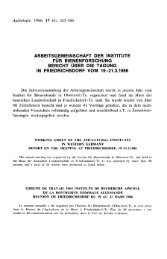

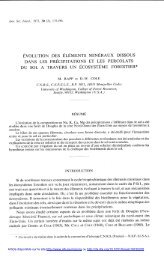
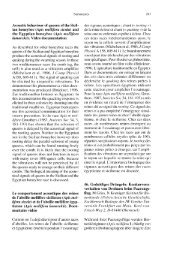
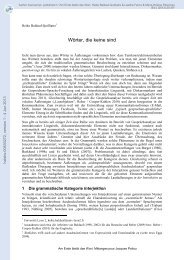
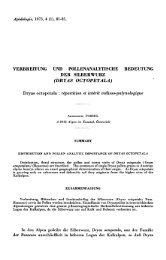
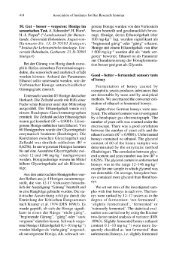
![4 C]-Polyethylenglykol bestimmt, der - HAL - INRIA](https://img.yumpu.com/22454280/1/177x260/4-c-polyethylenglykol-bestimmt-der-hal-inria.jpg?quality=85)
